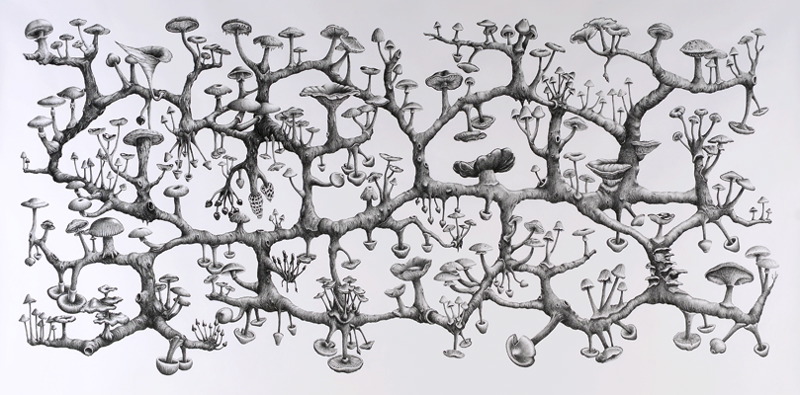
The Shape of Our Motions Over Time: Fungal Indeterminacy, Potential Immortality, Prehension, and Concrescence

“Fungi are famous for changing shape in relation to their encounters and environments. Many are “potentially immortal,” meaning they die from disease, injury, or lack of resources, but not from old age. Even this little fact can alert us to how much our thoughts about knowledge and existence just assume determinate life form and old age. We rarely imagine life without such limits—and when we do we stray into magic. [Mycologist] Alan Rayner challenges us to think with mushrooms, otherwise. Some aspects of our lives are more comparable to fungal indeterminacy, he points out. Our daily habits are repetitive, but they are also open-ended, responding to opportunity and encounter. What if our indeterminate life form was not the shape of our bodies but rather the shape of our motions over time? Such indeterminacy expand our concept of human life, showing us how we are transformed by encounter.”
The above passage comes from anthropologist, Anna Lowenhaupt Tsing’s, fungallly fantastic book, The Mushroom at the End of the World: On The Possibility of Life in Capitalist Ruins. Tsing suggest that mushrooms, particularly Matsutake mushrooms, can teach us how to better cohabitate with non-human species in a time of massive human destruction. It’s a great book!
Interestingly for me the above passage, specifically the part about how “our indeterminate life form being not our bodies but the shape of our motions over time,” reminded me of how some Whitehead scholars have described the pattern of the process of prehension and concrescence in Whitehead’s work. Some describe it as a snake-like trail of dead datum. Others, like Richard Lubbock, who references something else that many people think could be “potentially immortal,” describes it this way:
“Whitehead groups his occasions into ‘societies’. The most typical ‘society’ of his occasions is the human soul, as it grows in time. One pulse of enjoyment follows another, and, as their number grows, all the pulses form the serial society we call the soul. It is like a growing pile of coins. Each pulse takes in all the frozen data from its predecessors and adds novel feelings of its own. The occasion does not passively copy the past: in the act of self-creation it refreshes the design of the past, thereby inventing its novel present, and preparing for its possible futures. Whitehead calls these takeovers ‘prehensions’. The verb ‘to prehend’ means to engulf, perceive and transform […] So the soul of a human, or of an electron, or of a bacillus, is a sequence of prehensions, or takeovers, each of which prehends all its predecessors. As it grows in time the sequence defines the society called the soul. Your soul–your ‘Self’–is a pathway of dead occasions, with one living occasion at the very tip, the growth point. Whitehead calls this kind of sequence a ‘personal society’.”
This, to me, sounds somewhat similar to the “fungal indeterminacy” described by Tsing above. And that pathway of occasions with one growth occasion at the tip sounds a lot like a hyphae or mycelial network with a fruiting mushroom at the end… Well it’s one way to potentially visualize it anyway I suppose.
…
Image above: Mycelium Rhizome by Richard Giblett
0 Comments